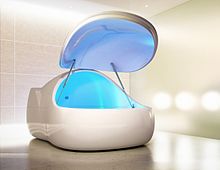Isolation tank
Contributors to Wikimedia projects
 Article Images
Article Images
This article is about the sensory deprivation device. For other uses, see Tank (disambiguation).
An isolation tank, originally called a sensory deprivation tank (a.k.a. float tank, flotation tank or sensory attenuation tank) is a lightless, soundproof tank with high epsom salt (magnesium sulphate) content filled with salt water at skin temperature, in which individuals float. They were first used in 1954 to test the effects of sensory deprivation.

Flotation is widely advertised on the internet as a form of alternative medicine with claims that it has beneficial health effects.[1]
History
The isolation tank was developed in 1954 by John C. Lilly, a medical practitioner and neuropsychiatrist.[2][3][4] During his training in psychoanalysis at the US National Institute of Mental Health (NIMH), Lilly experimented with sensory deprivation. After 10 years of experimentation without taking any psychoactive substances, he tried floating in combination with a psychedelic agent, mostly LSD (at that time he was a researcher at NIMH, and LSD was legal in the US).
According to one person in the industry, in the 1980s the rise of AIDS and the fear of shared water reduced demand for flotation centers.[5] By 2013 flotation was more popular in Europe than the US but had undergone some growth in the area around San Francisco; at that time a low-end tank cost about $10,000 and an hour flotation session cost about $70.[5]
Alternative medicine
Flotation has been widely advertised on the internet as a form of alternative medicine that has a number of health benefits, but the claims are often exaggerated and poorly-evidenced.[1] Despite the lack of scientific support, people have sought treatment from flotation for many conditions including muscle tension, chronic pain, hypertension, and rheumatoid arthritis to PMS.[6]
A 2005 meta-analysis of clinical trials that had been conducted at that time, found that the trials were generally small and highly prone to error, but given that limitation, use of isolation tanks, (called "flotation REST" or "restricted environmental stimulation therapy" in the literature) appeared to be useful for stress management.[7]
Notable users
Carl Lewis used in-tank visualization techniques to prepare himself for his gold medal long jump at the 1988 Seoul Olympics.[8]
John Lennon reportedly used a flotation tank in 1979 in an attempt to kick his heroin habit.[9]
Two-time NBA MVP, Steph Curry reportedly uses a sensory-deprivation tank every 2 weeks.[10]
See also
- Altered States, a 1980 film based on Lilly's experiments
- Dark retreat
- Prisoner's cinema
- Psychedelic experience
- Sensory deprivation
References
- ^ a b Jonsson K, Kjellgren A (2014). "Curing the sick and creating supermen – How relaxation in flotation tanks is advertised on the Internet". European Journal of Integrative Medicine. 6 (5): 601–609. doi:10.1016/j.eujim.2014.05.005. ISSN 1876-3820.
- ^ Black, David (December 10, 1979). "Lie down in darkness". New York Magazine. 12 (48): 60. ISSN 0028-7369.
- ^ Gelb, Michael; Sarah Miller Caldicott (2007). Innovate Like Edison. Dutton. p. 140. ISBN 0-525-95031-1.
- ^ Lilly, John Cunningham (1996). The Scientist: A Metaphysical Autobiography (3 ed.). Ronin Publishing. p. 102. ISBN 0-914171-72-0.
- ^ a b Efrati, Amir. "Float Centers Gaining Steam". The Wall Street Journal. Retrieved May 15, 2013.
- ^ "Why do people use flotation tanks?". BBC News Magazine. 2016-02-09. Retrieved 2016-09-23.
- ^ van Dierendonck, Dirk (2005). "Flotation restricted environmental stimulation therapy (REST) as a stress-management tool: A meta-analysis". Psychology & Health. 20 (3): 405–412. doi:10.1080/08870440412331337093.
- ^ "Floatation Tanks, Three Powerful Healing Therapies in One!". CNN iReport. Retrieved 2016-09-23.
- ^ Times, Special To The New York (1981-11-21). "RELAXATION TANKS: A MARKET DEVELOPS". The New York Times. ISSN 0362-4331. Retrieved 2016-09-23.
- ^ Alipour, Sam (8 December 2015). "Stephen Curry on copying the Warriors' way: 'You won't have the personnel'". ESPN. Retrieved 13 December 2016.